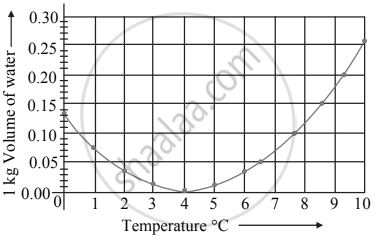Advertisements
Advertisements
प्रश्न
Give reasons for the following:
Even when the water in the lakes is frozen, fish can survive.
उत्तर
Even when the water in the lakes is frozen, fishes can survive due to anomalous expansion of water, water has maximum density at 4°C and this dense water remains at the bottom of the lake and the upper layer of water is less dense and freezes but the temperature of each layer of water below increases by 1°C. Thus it is warmer in the lakes below the ice layer. This helps the fishes to survive.C and this dense water remains at the bottom of the lake and the upper layer of water is less dense and freezes but the temperature of each layer of water below increases by 1°C. Thus it is warmer in the lakes below the ice layer. This helps the fishes to survive.
APPEARS IN
संबंधित प्रश्न
Explain the following:
In cold regions in winter, the rocks crack due to anomalous expansion of water.
1 kg of ice at 0°C is mixed with 1 kg of steam at 100°C. What will be the composition of the system when thermal equilibrium is reached? Latent heat of fusion of ice = 3.36 × 103 J kg−1 and latent heat of vaporization of water = 2.26 × 106 J kg−1.
Calculate the time required to heat 20 kg of water from 10°C to 35°C using an immersion heater rated 1000 W. Assume that 80% of the power input is used to heat the water. Specific heat capacity of water = 42000 J kg−1 K−1.
Consider the situation of the previous problem. Assume that the temperature of the water at the bottom of the lake remains constant at 4°C as the ice forms on the surface (the heat required to maintain the temperature of the bottom layer may come from the bed of the lake). The depth of the lake is 1.0 m. Show that the thickness of the ice formed attains a steady state maximum value. Find this value. The thermal conductivity of water = 0.50 W m−1°C−1. Take other relevant data from the previous problem.
Explain, why are soft drink bottles not completely filled?
Explain, why are the exposed water pipes lagged with straw during severe winter?
What are land and sea breezes? Explain with the help of a labeled diagram.
Observe the given graph and answer the following questions:

- Name the process represented in the figure.
- At what temperature does this process take place?
